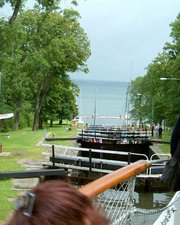|
|
Göta Kanal is a Swedish canal constructed in the early 19th century. The canal stretches all the way from Gothenburg on the Swedish west coast, combined with river Göta älv and Trollhätte kanal, through the great lakes Vänern and Vättern, in parallel with Motala ström, and to Söderköping on the Baltic Sea.
The architect was Baltzar von Platen, working to plans earlier developed at the request of the Swedish king by the British engineer and architect Thomas Telford; he got permission to begin work on April 11, 1810 and the canal was officially opened on September 26, 1832. Telford himself travelled to Sweden in 1810 to oversee some of the initial excavations on the project. Built only decades before the advent of railroads (see Rail Transport), the canal was soon outdated, and never upgraded. The canal is a tourist attraction, sometimes called the blue ribbon of Sweden.
To support the building of the canal with mechanical works, a small engineering workshop was establihed in Motala called Motala Verkstad. This industry is sometimes called the "Cradle of the Swedish engineering industry".
| Contents |
Stops
The stops during the full trip are Göteborg, Göta älv, Lilla Edet, Trollhättan, Vänersborg, Vänern, Läckö, Årnäs, Mariestad, Tiveden, Sjötorp, Lyrestad, Norrkvarn, Töreboda, Wassbacken, Lanthöjden, Tåtorp, Viken, Unden, Forsvik, Rödesund, Karlsborg, Vättern, Vadstena, Motala, Borenshult, Boren, Borensberg or Husbyfjöl, Långkanalen, Bergs slussar, Roxen, Norsholm, Asplången, Klämman, Söderköping, Mem, Slätbaken, Baltic Sea, Södertälje kanal, Mälaren, Hammarbyleden, Hammarbyslussen and Skeppsbron.
Photographs of Göta Kanal
See also
External links
- Göta Kanal (http://www.gotakanal.se/) - Official sitesv:Göta kanal

